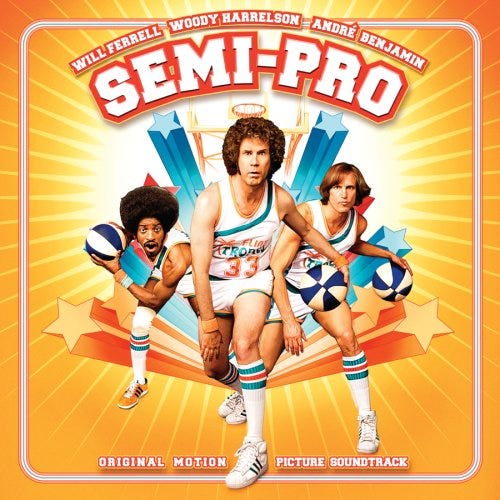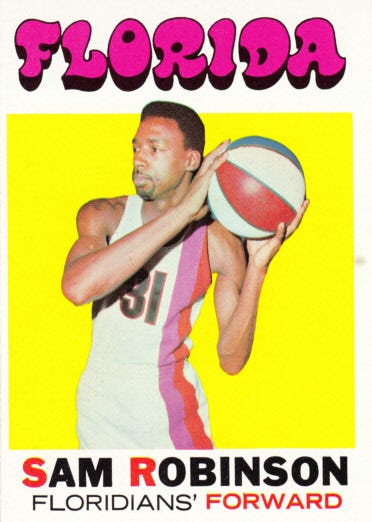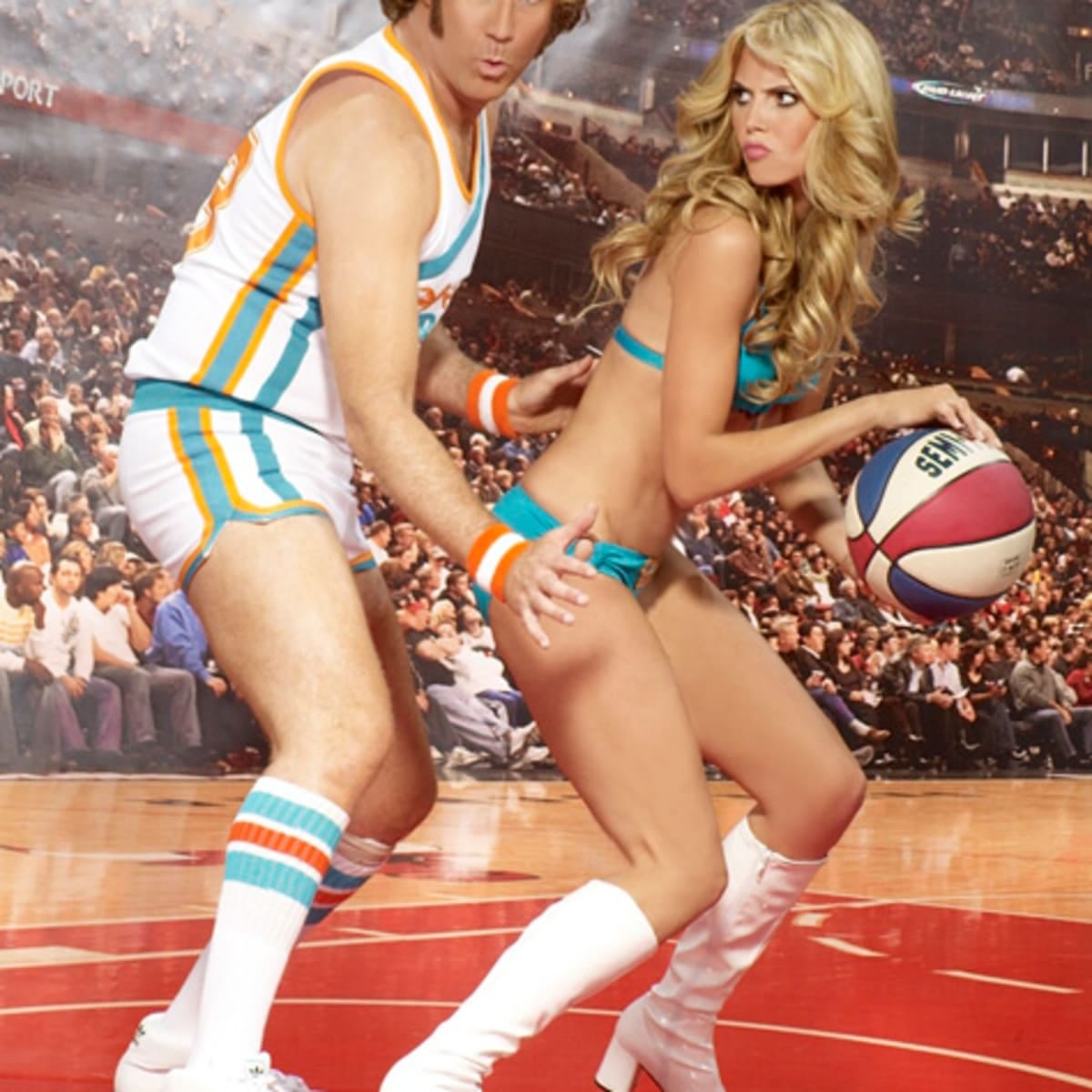How Semi-Pro Could Have Been So Much Better
Last week, Indie Wire published a ranking of the best comedic films of the 21st Century.
The list…well, it sucks. But it did generate a lot of good chatter in my corners of social media, reminiscing about some of the outstanding comedies released since 2000.
My own top 10 reminded me of what an absolute force Will Ferrell was in the Aughts, depicting some of the most hilarious and memorable characters of cinematic comedy, like Jacoby Mugatu, Frank the Tank, Ron Burgundy, Brennan Huff and Ricky Bobby.
But for anyone as prolific as Ferrell, especially in the 2000s, misses are inevitable. Steph Curry shoot 43.3 percent from 3-point range, right?
Ferrell’s portrayal of NASCAR driver Ricky Bobby in the excellent Talladega Nights was the standout in a run of sports-themed movies from 2005 through 2008. Ferrell starred in the forgettable figure-skating vehicle Blades of the Glory, the awful (albeit forgivably, since it’s a kids movie) soccer film Kicking & Screaming, and the most disappointment of the bunch, 2008’s Semi-Pro.
Semi-Pro offers a premise with a ton of potential. It’s an idea worthy of a mulligan, and I know just the person to fix its flaws: ME.
ABA History
Now, I deem Semi-Pro most disappointing because I’ve long found the American Basketball Association endlessly fascinating. The league struggled to gain enough fan support to survive, and yet, it forced the NBA to modernize in ways that arguably saved the league from falling into niche status.
Innovations like the 3-point line and dunk contest arguably proved as vital to the NBA’s popularity boom in the ‘80s as the influx of star power. Semi-Pro is a comedy, so I don’t expect a history lesson to bring the humor to a screeching halt, but there were some missed opportunities to integrate the ABA’s identity into gags.
The 1976 ABA All-Star Game is iconic, and coincides with the timeline of Semi-Pro as occurring in the league’s final season. It’s a last hurrah for what made the ABA great, with a team of All-Stars playing the first-place (and NBA-bound) Denver Nuggets.
The league held a star-studded dunk contest at halftime that featured legends-in-the-making David Thompson, Artis Gilmore and the winner, Julius Erving.
A fictionalized homage to this moment wherein Jackie Moon interjects himself would have been a nice nod to ABA lore. And speaking of integrating ABA lore…
Loose Balls
Growing up with a father who regularly attended ABA games, my interest in the defunct league was piqued at a young age. Thus, I read Terry Pluto’s definitive history Loose Balls as a teen and have reread since.
Although above I note integrating too much real ABA history potentially derails the comedy, Loose Balls recounts SO MANY true stories that are objectively hilarious — a lot of them more so than some of Semi-Pro.
Marvin Barnes was a troubled soul whose life story isn’t a laughing matter. But Barnes played for the Spirits of St. Louis — the organization that most closely mirrored the Flint Tropics in real life as the ABA lone survivor spurned by the NBA merger — and in his professional career, he made some of the most funny quips ever in sports.
The most famous is, before a short plane ride across time zones, in which the jet would touch down in its destination earlier than when it took off, Barnes saying, “I ain’t getting on no damn time machine.”
Barnes was the ABA’s Yogi Berra, a dude just constantly rattling off one-liners. Check out this Washington Post retrospective that recounts some of the best.
Another tale from Loose Balls that would have been a small but nice touch is that of the Anaheim Amigos. An organization that drew poorly even by ABA standards, a member of the Amigos front-office staff was assigned to spend home games spinning the arena turnstile in order to inflate reported attendance.
A Change of Scenery
A central joke in Semi-Pro is the delusional owner/coach/player Jackie Moon naming a team in Flint, Michigan, the Tropics. It’s clever if you’re 14.
Otherwise, the setting leaves what should be a fun and colorful movie against a drab and dreary backdrop. Compare Semi-Pro to contemporary comedies Starsky & Hutch and Anchorman, both of which are set in bright and sunny locations that enhance the story’s aesthetic.
The whole Flint thing is especially odd, given that the uniforms — also an underlying gag of the film — are just the actual Miami Floridians ABA unis in a different color scheme.
That noted, I’m not sure Miami is the setting I’d choose for Semi-Pro. My suggestion gets into the nuts-and-bolts of Hollywood somewhat, so it may not be feasible, but I offer up San Diego with the fictional ABA franchise existing in the same universe as Anchorman.
Now, Semi-Pro is a New Line Cinema film and Anchorman is DreamWorks. While both were written by frequent collaborators with Ferrell and that crew, Scot Armstrong (Semi-Pro) being able to use a character or two created by McKay (Anchorman) may not have been workable.
However, with David Koechner already involved in Semi-Pro, his bit role would have made for a nice cameo with him reprising Champ Kind as the reporter chronicling the team’s pursuit of an NBA invite.
Further, San Diego had a noteworthy history within the ABA that I am covering in this newsletter in much greater detail this summer. I don’t want to spoil too much, but there’s a lot of real-life gold that would translate well to a comedy: For example, the San Diego Conquistadors signed Wilt Chamberlain to a player-coach deal that fell through due to an NBA injunction.
Chamberlain fulfilled his coaching duties, but appeared on the Qs sideline in flip-flops and shorts. A nod to this moment, and Jackie Moon having it out with Los Angeles Lakers brass over his outlandish contract, would have made for great material. And, yes, I’m assuming the NBA is granting licensing to mention the Lakers given that the San Antonio Spurs are depicted in the film, and the NBA willingly signed onto the abominable Whoopi Goldberg vehicle, Eddie.
Reimagining Ed Monix
The most surprising element to Semi-Pro when I first it was that, while Will Ferrell was EVERYWHERE marketing the film in his Jackie Moon attire, Woody Harrelson’s character Ed Monix is more so the main character.
While I understand Ferrell being the face for marketing, given his hot streak in the half-decade preceding Semi-Pro, Harrelson was already well-established as a top-tier actor. He appeared in No Country for Old Men, released just a few months earlier and an Academy Award winner the same week as Semi-Pro’s release.
What’s more, Harrelson gives the basketball elements of the film a legitimacy. He was a great choice, and he does well with a script that’s…a little weird for his character.
The Jackie Moon stuff and the Ed Monix story come off like they were stitched together from two different scripts. Moon is pure Anchorman-style absurdity. With some minor changes, Harrelson’s courting of Maura Tierney could have been a Judd Apatow film of the era.
I appreciate the grounded storyline playing out through Monix — minus the inclusion of an actual cucking subplot involving Rob Corddry’s, whose character REALLY doesn’t need to be there. I also appreciate the effort to include a straight man to offset the wacky supporting characters, a staple of Armstrong’s writing in the 2000s, with Breckin Meyer in Road Trip and Luke Wilson in Old School as examples.
But those films are far less slapstick than Semi-Pro. This felt like an attempt to mesh Armstrong’s typical style with the wildly popular McKay approach, and it just doesn’t click.
I would ultimately fix this by making Monix the undisputed lead character, and take inspiration from Harrelson’s previous basketball endeavor, White Men Can’t Jump, to weave the humor and ABA history into a comedic story. Meanwhile, Jackie Moon’s character is less of a focal point — not being on the team, though interjecting himself, the owner, as coach after the failed Wilt experiment — and used for the slapstick beats; much in the same way Armstrong wrote Ferrell’s Frank the Tank in Old School.






